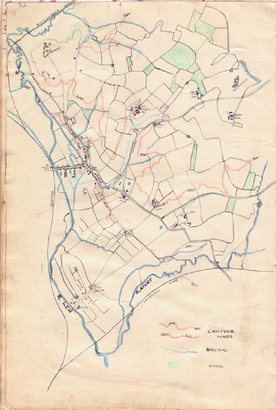
WOODS STREAM FIELDS AND TREES
Our parish can be described as reasonably well provided with woods, particularly the Easneye estate and Bonningtons, while most hedges are lined by elm trees. Chief trees are oak, elms, fir, sycamores, ash, horse chestnut, spanish chestnut, limes, silver birch, and a row of poplars lines the back fence of Thele farm, towards Thele Avenue and there is a fine cedar beside Cats Hill. The strip of wood at the Folly consists of splendid beeches. Blackberry and spindle bushes are prevalent. Streams are plentiful, with the largest running down the Hunsdon road valley, alongside the Thele estate Vicarage and under Roydon Road to the river. Springs flow freely in Chappell Fields, their courses varying frequently. Drinking fountains at the parish hall and church used to be fed by such springs but neither of them now works.
Other streams flow across fields on the north of the High Street, one through the gardens of no. 11 and another alongside of the Town Mead. The Rye Meads are so low lying that ditches have been dug around almost every field and were, even so, flooded frequently.
Our boundaries are formed by Rivers, the Ash on the NW, the Lea on the W and the Stort on the south and SE and as the map shows much land is liable to floods. In March 1947 all land below 100ft was under water for three days, food being delivered to South Street and High Street by boat.
Rabbits are very plentiful everywhere and foxes may occasionally be seen. Otters too are fairly common and Mr. Miller is famous for his skill in catching them. Pheasants are common and shoots around Easneye are held regularly:
Soils.
During the past few weeks borings have been made across Rye Meads with a view to the laying of sewers for the new town at Harlow.
The contractors gave us the following information about the subsoil etc.
1. Boring (near Rye Gate farm)
Total depth reached = 35ft
Clay 0 – 7ft.
Ballast 7 – 33ft (saturated with water ).
Chalk 33ft downwards.
2. Digging (end of Elephant Lane).
Soil 0 – 3ft downwards.
Clean sand, stones 3 – 7ft.
Gravel 7ft downwards.
The lower strata is chalk but when the boring was visited this had not been reached.
Below is the copy of the Toll Board at Rye House toll gate.
This road connects to roads leading to Harlow, Sawbridgeworth and Bishop’s Stortford also Roydon and Epping.
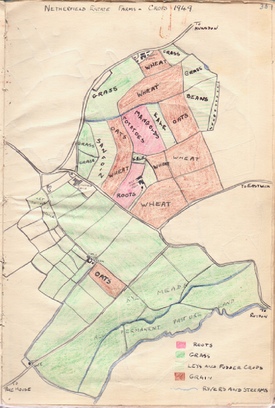
S d
For each traction engine 2 6
Caravan or wagon drawn by same 6
Private motor car 6
Motor lorry charabanc or omnibus 6
Motor bicycles or tricycles 6
Push bicycles or tricycles 1.5
For every horse mare etc 1.5
For every head of cattle 1
For every drove of sheep or hogs at per score 5
NETHERFIELD FARMS
Total acreage 460 made up of 234 ½ acres of cereals, and 24 acres of roots, 201 ½ acres of pasture.
At Home Farm there are 42 pure bred Guernseys giving about 35 gallons of milk each per week. At little Rye Farm there are 64 Aberdeen Angus and Red Poll beef cattle. 12 Suffolk Punch horses, 12 Black and White and Large White pigs and 200 Light Sussex, Black Leghorn and Andalusian fowls are kept. The farms use three tractors.
LITTLE BRIGGEN’S FARM
Total acreage 600, made up of 40 acres root crops, 230 acres grain, 330 acres grass and fodder crops. About 170 Shorthorn cattle are kept, a sale being held at the farm in October each year. Three Shire and Percheron horses and six tractors are used. 50 Essex pigs and about 50 Light Sussex /Rhode Island Red fowls are kept.
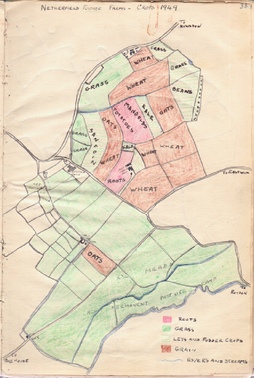
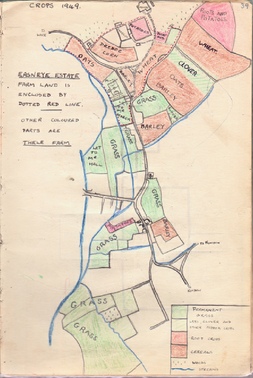
THELE FARM – TENANT MR. R W CHAPMAN.
Acreage: 270 made up of 100 acres grains 30 acres roots and 140 acres of pasture.
Dairy herd of 40 cross bred shorthorn cows yielding roughly 455 gallons per week , which is sent to Deddens of Edmonton. 3 horses, 30 crossbred pigs and about 200 fowls. This farm has about 1/3 high land which is ploughed and 2/3 low lying land, liable to floods, on which the cattle graze. Most of the buildings are very old.
Easneye Estate has always had a dairy farm, but during the war, 60 acres were ploughed in the park, including the cricket pitch. At present roughly 50 acres of corn and 10 acres of roots are grown, but the dairy farm no longer keeps any cows several fields being let to various farmers instead. Six men are employed in farm or garden work.
Mr. G F Storer who keeps about 24 cows of various breeds, rents fields from Easneye and from Miss Prior and produces average, 120 gallons of milk daily. This is sold locally by Hebbs Dairy of Rye Park.
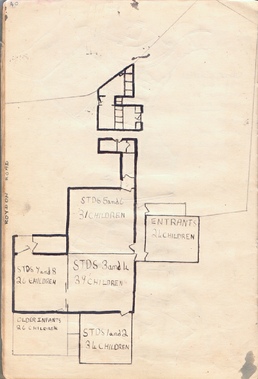
THE SCHOOL
The plan shows the school building . Present numbers are infants 48, Juniors 73, Seniors 62, with a staff of a Headmaster and two men and four women assistants.
Classes go to Broxbourne for handicraft (boys) and domestic subjects (girls) while visiting teachers come to the school to teach needlework, shorthand and typing, and handwork.
Teams compete in the boys’ football and girls Netball Leagues, and the school holds the mixed schools shield for athletic sports . The picture below is of the school from Roydon road.
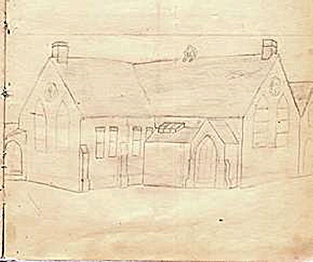 Continued
Continued